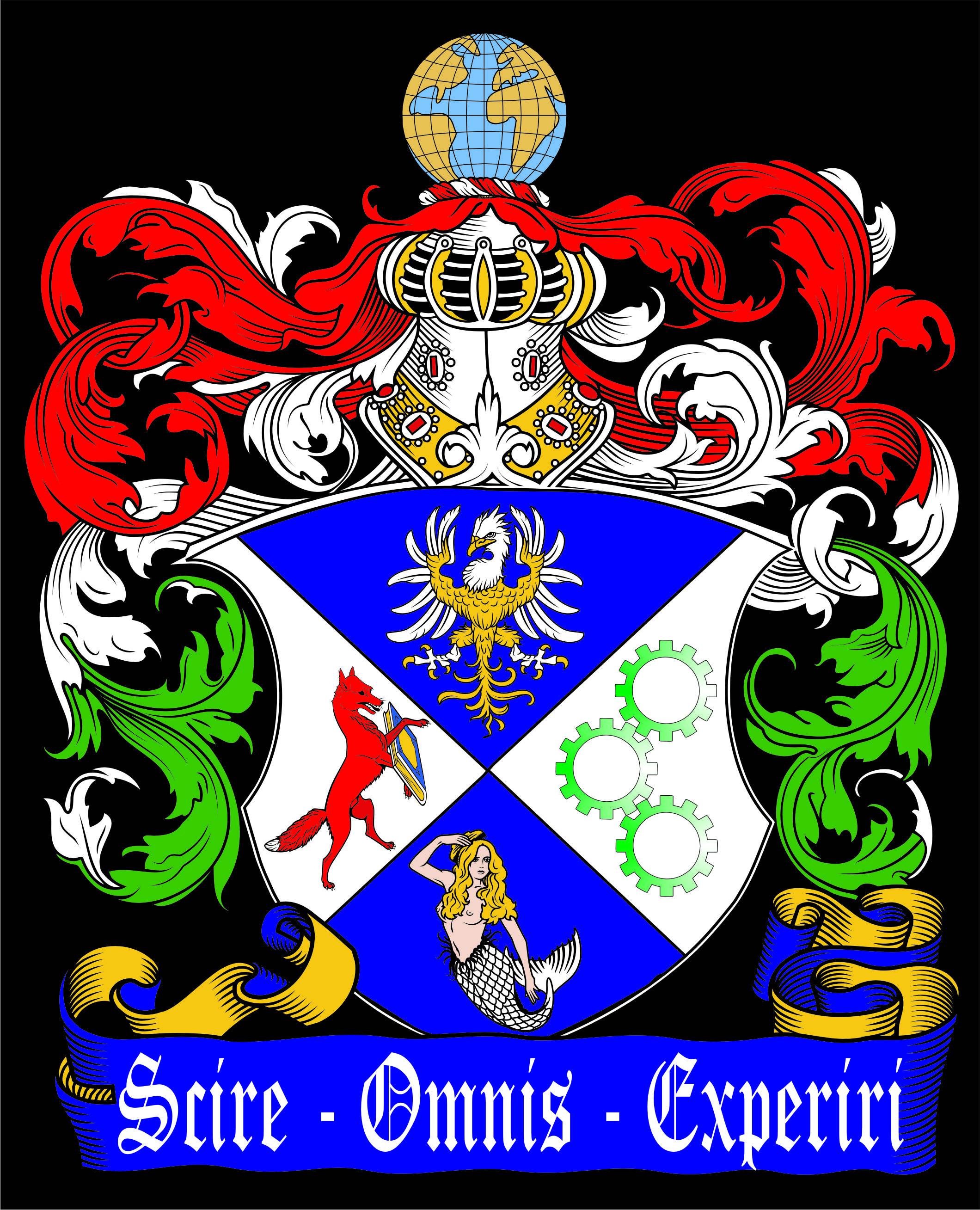|
I'm gonna go way out on a limb here and discuss my experience with synthesizers.
Out on a limb, because I don't really know where this will go. I may get bored with it.
I may get good at playing a synthesizer, but I know my limitations.
I took years of piano lessons as a kid in Germany and never really got into it enough to practice.
My first piano teacher was Herr Penz. A Prussian with a penchant for discipline.
The only thing I can really remember him saying was "Finger luepfen, Finger luepfen!",
by which meant to really hit those keys.
Fast forward to 2024
My friend Roger Arrick
created Synthesizers.com
in the mid-1990s and built Moog style modular synthesizer parts.
He gained a huge following, with some notable famous musicians as clients.
In December 2023, I wanted to give my grandchildren a gift for Christmas that would last a long time
and teach them something not just about music, but about how sounds are generated.
A synthesizer seemed the perfect choice.
So I asked Roger what I should get as a beginner's synthesizer.
He steered me, among a couple other possibles, to the Korg Monologue,
a monophonic (one note at a time) analog synthesizer that was around $350.
I bought one and shipped it to my son Talon in Michigan.
He called me when it arrived and said "Dad, thanks for the thoughtful gift. But really.
These kids are way too young. They will break it the first day!"
Of course he was right. I was getting a little ahead of my skis.
So I thought, how can I "make lemonade" out of this?
The AUDeQSL
If you know anything about ham radio and QSL cards, you might know that in 1998, I created
the Electronic QSL Card Center eQSL.cc, a cloud service where ham operators
exchange their QSLs electronically. I have over 400,000 users across every country on earth.
What if I were to create an Audible eQSL?
In addition to the graphical version of an eQSL, I could add a sound option and make them AUDeQSLs!
So I set about to add a feature that not only reads the card's QSO details to the recipient using text-to-speech,
but also lets the card owner upload a sound file that would be played with the main graphic of the card.
I suggested people record a 20-30 second clip of themselves describing their ham shack
or something about themselves.
And I would create a small library of audio files they could choose from, instead of recording their own voice.
And I would use my new synthesizer to create the background sounds,
and they could also have me record their callsign over the background sound.
Here are some of those sounds I created on the Monologue synth, with a sample of my callsign (N5UP) voiced over:
* 73 (in CW)
[Sample (N5UP)]
* Bass A Minor
[Sample (N5UP)]
* BladeRunner
[Sample (N5UP)]
* Chariots of Fire 1
[Sample (N5UP)]
* ClairDeLune
[Sample (N5UP)]
* Close Encounters
[Sample (N5UP)]
* RadioMoscow
[Sample (N5UP)]
* Space Odyssey
[Sample (N5UP)]
* The Lid
[Sample (N5UP)]
* Toccata
[Sample (N5UP)]
After AUDeQSLs, what's next?
While I was doing that, and researching all of the popular songs that were recorded with a synthesizer,
such as "Thriller", "Bladerunner", "Chariots of Fire", all the Switched-on Bach music, "Jump", etc. etc.,
I turned my focus on Pat Metheny and all of his work with synthesizers that I had so loved in the 1980's.
And in doing so, I rediscovered one of his main collaborators named Lyle Mays.
Pat Metheny and Lyle Mays
I'm pretty sure it was Roger Arrick who initially turned me on to Pat Metheny and Tomita around 1979,
and I bought the Pat Metheny Group album
and the Offramp album.
The As Falls Wichita, So Falls Wichita Falls album he made with Lyle hit the top spot on the Jazz chart in 1981.
(If you get a chance to listen to September Fifteenth from that album,
sit back and relax and prepare to shed some tears and realize this is just 2 guys making this incredible music!)
In 1987 I attended a live Pat Metheny Group concert in Lewiston NY
while I was living in Buffalo, and it was such an emotional experience, it made a lifelong impression on me!
After listening to everything Lyle Mays composed and played, I realized he was among the greatest composers
to ever have lived. In 1975, when I was just discovering computers, he was 22 and responsible for composing and arranging
all the music produced by the One O'clock Lab Band at NTSU (now UNT).
Not only did his synergistic work with Pat Metheny produce exquistely complex, soulful, hauntingly beautiful songs
full of emotion, and very memorable, but his ability to play a Steinway piano on stage with one hand,
and his Oberheim or Prophet-5 with the other hand - without looking - is just extraordinary.
The "Bendy Flute"
I noticed that he had developed an unusual type of flute sound that often led the melody in a few of his songs, and so I Googled it.
Sure enough, it's a "thing". Some were calling it a "bendy flute", and indeed, his intention was to copy
what he had heard many young flute players doing in practice. They would play the note, and then slightly adjust
the frequency to match the other flute players. This results in an almost imperceptible, quick rise and fall
of the note at the very beginning. And this can be emulated with a synthesizer!
(You can hear a very short 15-second passage of this bendy flute at the 3:00 mark in the September Fifteenth video above.)
I watched a YouTube video
that showed how to replicate that sound on a Prophet-5. So I tried for days to re-create that sound on
my little Korg Monologue. I got close.
But I was coming to the realization that I was going to want to play chords if I wanted to play Lyle's music.
Since all my computers nowadays are MacBooks, I already had a free copy of GarageBand, which allows recording
multiple tracks, editing, creating separate melody and bass tracks, etc.
But it was still going to be too limiting to do all the chord work in GarageBand.
Not only that, but no piano teacher would be willing to teach me on a little 2-octave, 25 key keyboard with no ability to play chords.
Korg Minilogue XD
So I went to Guitar Center and traded in my Monologue 1-voice for a Korg Minilogue XD,
which not only has a 3-octave 37 key keyboard and 4 voices
(so I can play one melody and 3 fingers of harmony simultaneously), but it also has a reverb and delay section
that will allow me to play more ethereal sounds.
I found it easier to replicate the "bendy flute" sound now with the Minilogue, and I set out to learn to play
one of his early compositions: "Close To Home".
Close To Home
This is a song that is so memorable that audiences break into applause upon hearing just the first 4 notes played on the piano, which are the key melody.
Lyle Mays playing Close to Home
(at 1:45 you start hearing the synthesizer, and at 2:13 the synthesizer's "bendy flute" becomes more prominent,
at 3:39 the flute takes over the melody entirely.)
My first attempt to play anything on the Minilogue beyond the AUDeQSL sounds.
Since the melody has a grand total of 5 notes, played up and down the keyboard in different keys, it is easy to master with the right hand!
I did not attempt to play all the harmonies, but rather just picked out a few noteworthy chords and sounds to add to the melody line.
(Even though I hope later people can laugh at my simple little exercise, I'm going to leave it here to show how far I've come in a few years from now!)
Other pieces I want to play on the synthesizer that have strong "bendy flute" parts are
It's For You and
Are You Going With Me
(This live performance shows Lyle playing a piano and synthesizer, and then 2 synthesizers simultaneously!)
The Search
| Looking over the music and trying to pick out things I can play. Don't hate... it's easier to find the keys with stickers for now |
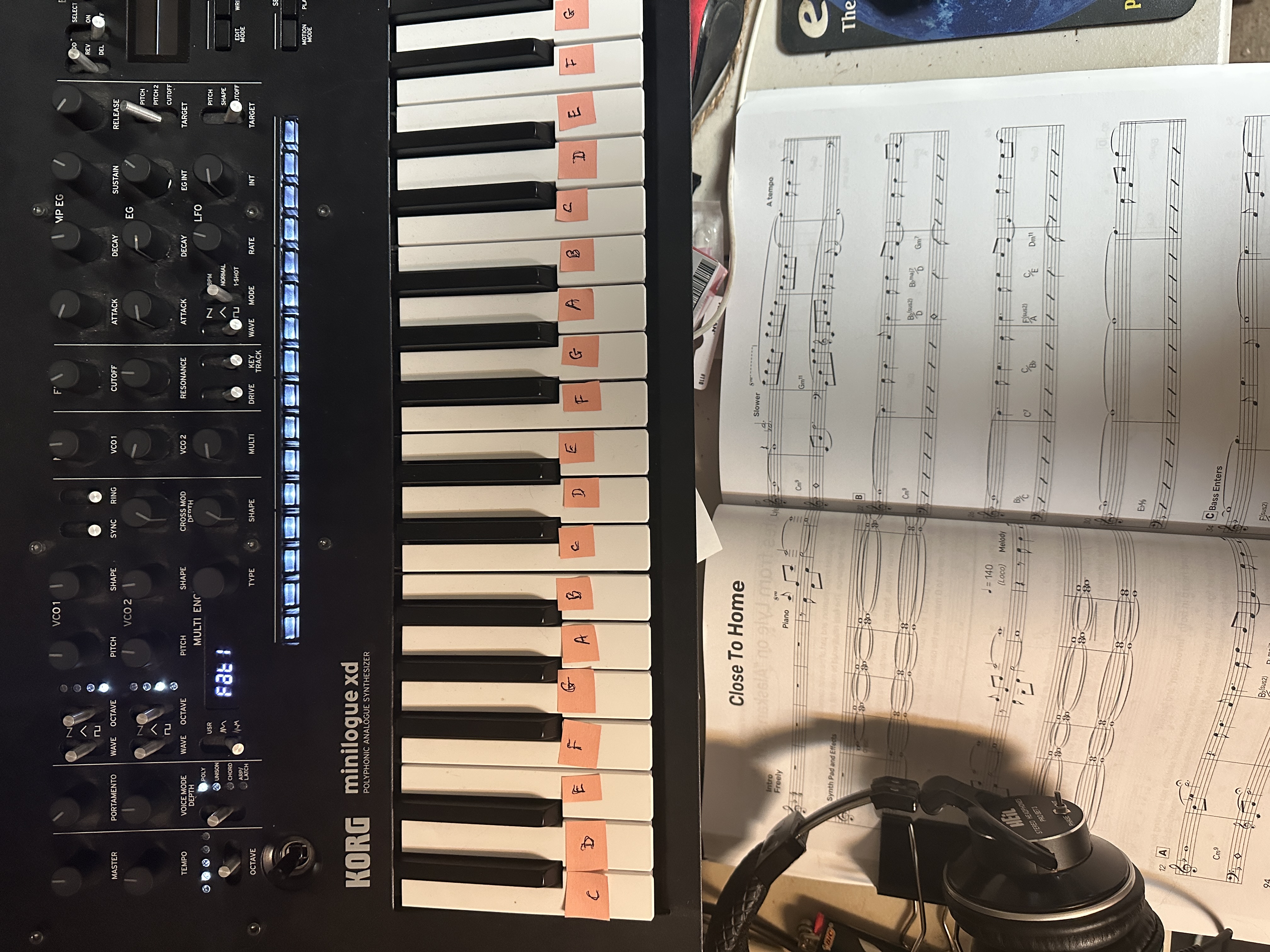 |
February 10, 2024
Lyle Mays died on this day 4 years ago, and the world lost a genius composer and piano/synth player,
the likes of which we will never see again.
I have signed up for online piano lessons with someone who "gets" my desire to focus on aspects of synthesizer playing.
I have no interest in the traditional, classical piano playing. I want to play the things that move me.
(Surely I can learn finger movements using Close To Home, It's For You, The Search, and other pieces as easily as I did with Bill Grogan's Goat when I was 9!)
I bought the Pat Metheny Songbook
and the Lyle Mays sheet music
to study some of their incredible music.
As I write this, it is the 4th year to the day since we lost Lyle Mays, a composer and piano/synth player without equal.
Rest In Peace, Lyle Mays.
February 11, 2024
I woke up this morning humming the (flute) theme music to the TV series "Kung Fu"
and wondering if I can play it with my synthesizer tuned to a pentatonic minor key,
a flute sound I created from scratch, and a
So I headed to the DaveCave and sure enough, I could. So I created this little piece: Kung Fu
All the sounds, the flute, the drums, the bells, and the second synthesizer harmony, come from experiments in the Minilogue and were assembled in GarageBand.
February 12, 2024
After watching several YouTube videos of Nahre Sol, I bought and downloaded her Elements of Music, and have been studying it.
February 14, 2024
Received my Pat Metheny Songbook in the mail from Hal Leonard, opened it up to "Last Train Home" on page 224, and starting plinking.
Last Train Home.mp3 is the result. After dinking with the automatic percussion in GarageBand, and realizing that I was slow in some of the synthesizer parts
(because I couldn't get my fingers to cooperate), I decided to use the microphone to make the steam locomotive percussion sound that is such a trademark of this song.
Here's the real thing: Last Train Home from the album Still Life Talking.
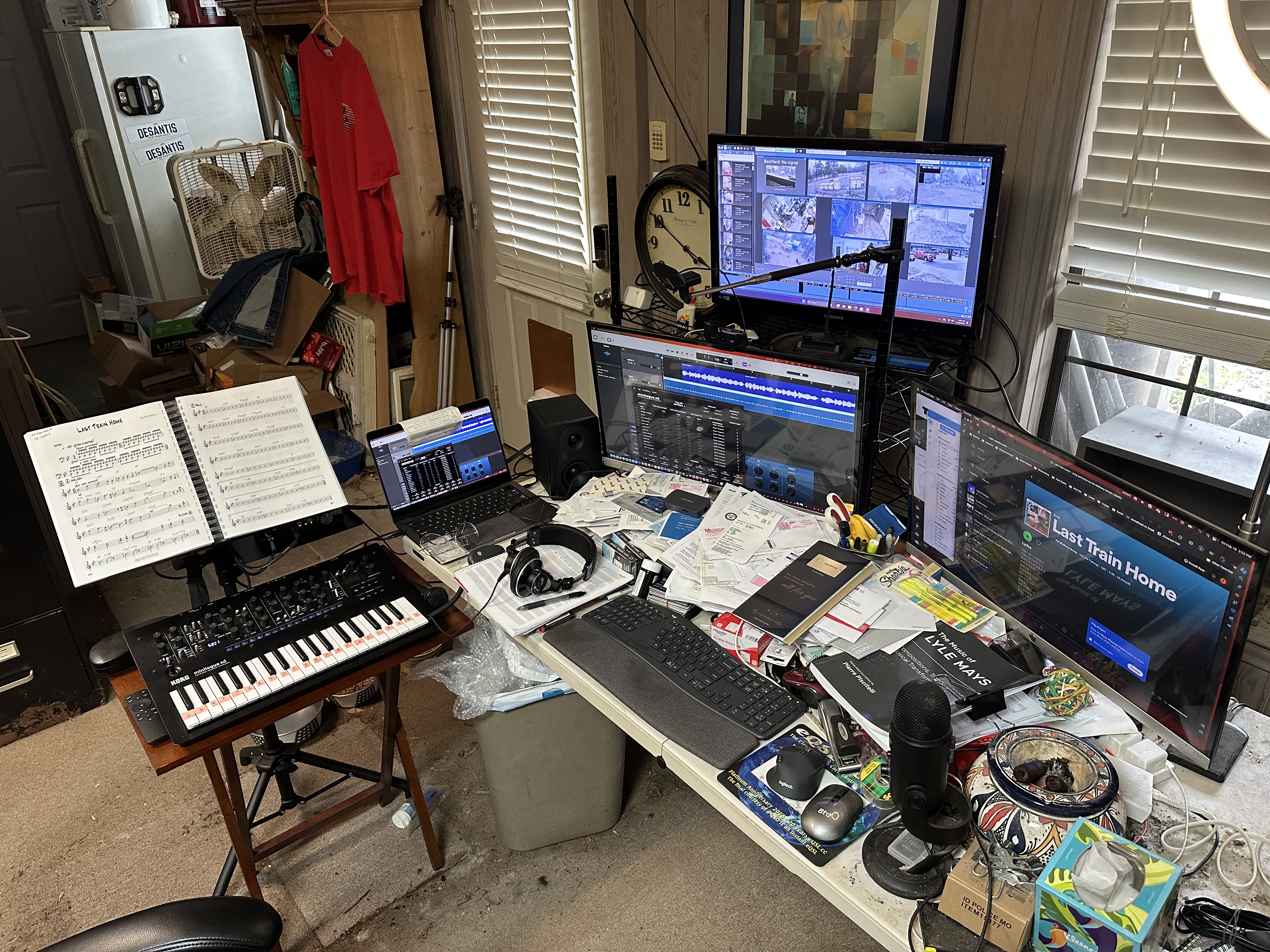 |
Yes, I'm a nerd. Synthesizer at far left, MacBook Pro, dual screens, and my surveillance camera system watching over it all. And I need to clean up my desk. |
February 20, 2024
I had my first piano/synth lesson over Zoom today with Josh F from TakeLessons.com.
He understands that I don't want to just take the typical piano book lessons that a 9 year old uses to learn classical piano,
but that I have a different focus at this point in my life, and he's totally onboard.
He's going to fill in the missing gaps in my understanding of music theory as well as working on technique
using Last Train Home as a starter song. Awesome!
True, the melody in this song is played by Pat Metheny on a guitar, and it doesn't use the "bendy flute",
but it's a fairly easy melody and will give me some good practice.
February 26, 2024
2nd piano/synth lesson.
(Difference between 9 year old not really into piano and 68 year old with huge motivation: probably an hour a day - and sometimes 3! - of practice that I actually enjoy!)
We spent time focusing on the lead sheet for Last Train Home. I am getting fairly good at playing the melody,
so we spent more time looking at the chords in the harmony part, and after practicing some more after the lesson,
here is Take 2 of Last Train Home using Garageband to add the percussion and chords.
(I used some presets for the Minilogue XD I bought from Ultimate Patches
and tweaked them for the Melody ("281-Jupiter 6") and the chords ("185-Juno-106"), and I crafted the brush percussion myself
from the white noise generator in the synthesizer.)
March 2, 2024
I figured out how to get a more realistic sound of 2 brushes by using the Delay effect timed
so I can play the main brush sound at 160bpm and get an effective 320bpm rhythm with the second brush a little lighter than the first, which sounds more like a real percussionist.
I've incorporated that into the link for Take 2 above.
March 5, 2024
Simulating an acoustic guitar is one of the thornier problems for an analog synthesizer like mine.
So I watched an entire 2 hour video tutorial
on the Korg Minilogue XD, which taught me many things I did not know, and which is probably the finest tutorial anywhere on the web on the Minilogue XD,
and then I read 3 different articles on how to attempt to synthesize plucked strings,
and then I set out to try to do it.
For anyone who cares, what I ended up with was VCO1 set to triangle wave and VCO2 set to sawtooth. Shapes set to zero.
This gives the sound a little more fizz than if they are both set to triangle, which would sound too soft.
I gave VCO1 more volume than VCO2 and set the Filter to about 75%, no resonance.
In the ADSR, attack is 0, and I added about 45% delay, 55% sustain, and toyed with the release until it sounded like guitar strings would sound after you pluck them and they taper off in volume.
The real trick I used was to set the Arpeggiator at a very fast tempo so that when you press keys to make a chord, it will actually "strum" the individual notes,
much like a guitar would sound. (On a guitar, you can't hit all notes in a chord simultaneously!)
To play this, you have to strike the entire chord in one motion on the keyboard with your fingers just for a fraction of a second to let the Arpeggiator read the notes and it will then play them individually, very fast, like strumming the strings.
(If you hold the keys too long, it will repeat and screw up everything!)
Here is the new Last Train Home with the synthetic guitar now playing the bass line.
Next I'll play the harmony using a piano emulation instead of the guitar, since that's what I believe they actually used in the performance. It's all just an experiment in creating sounds! :)
Stay tuned!
March 22, 2024
I've had a couple more piano/synth lessons during which I've been learning a lot about music theory.
See, when you're a 9 year old kid, they just teach you to play the notes on the page, and don't get into E7sus4 and Bbmaj7 and stuff like that.
So this is a lot of fun, but it's also kinda like trying to take a sip out of a fire hydrant.
My teacher Josh is totally willing to go anywhere in the half-hour lesson that I want to go, and he's always able to find something really important to teach along the way.
One of the things I complained about was that I want my fingers to naturally go to the right keys when I hear some music or read the notes. Right now I'm hunting and pecking.
So he suggested I start with something a little friendlier than Last Train Home, and he suggested I learn Yesterday by John Lennon and Paul McCartney.
And so here is my rendition of the first page of Yesterday.
(I actually played it with 3 different sounds from the synthesizer, just for grins.)
Now, HAHA! It sounds like I've got this fingerwork down pat, doesn't it. But I cheated. I used a Novation LaunchPad Pro MK3 that I just bought.
| The Novation LaunchPad Pro MK3 (at left) has 4 tracks of 8 patterns of 32-step sequencing capability. I think that's 1,024 steps versus the 16 that are built into the Minilogue. |
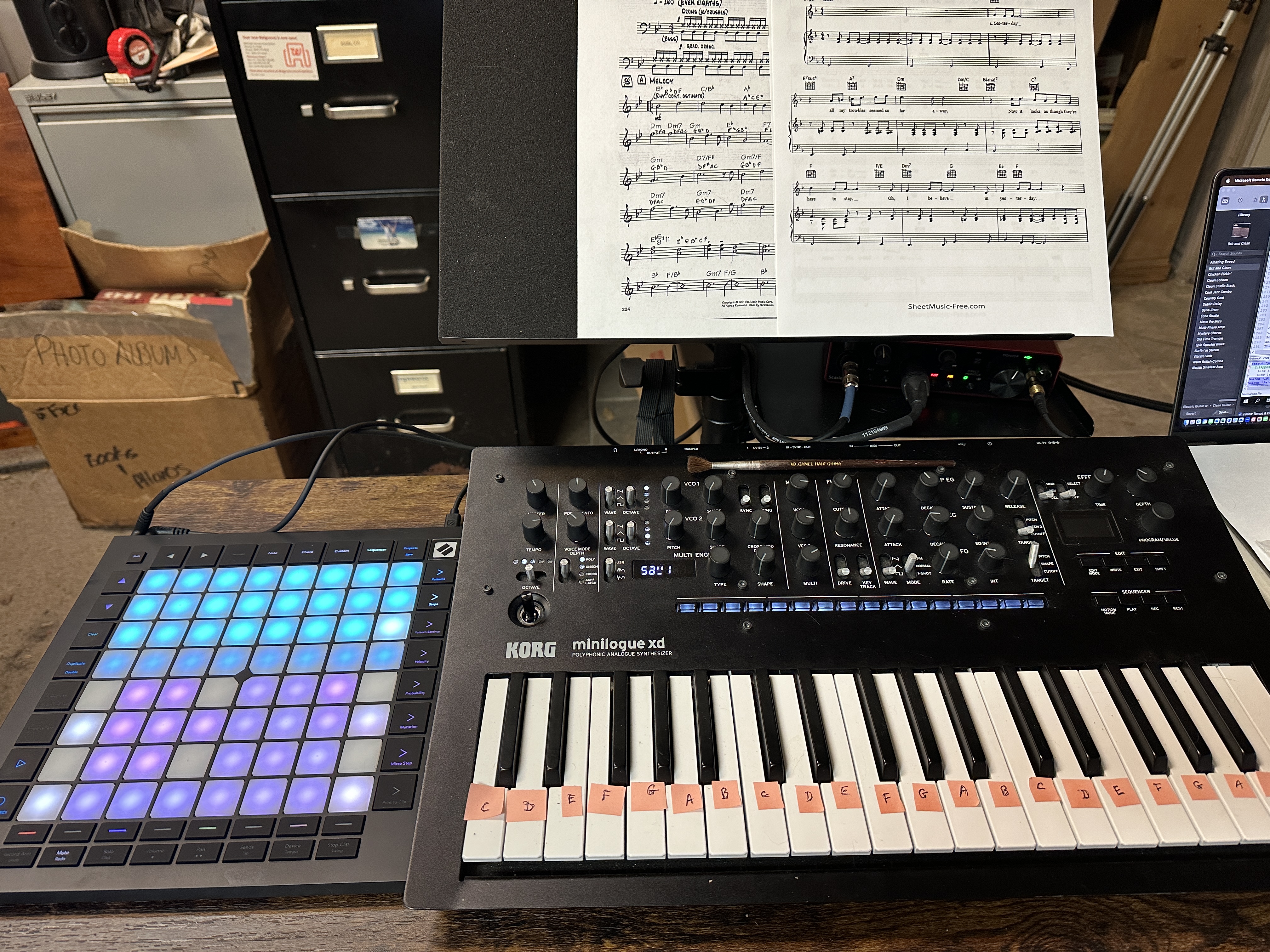 |
So, by using the massive sequencer in the LaunchPad Pro, I first recorded all the chords in Yesterday so each chord could be played by touching one of the square pads, and then tapped them with the right beat into Garageband.
And then I recorded the single-note melody for Yesterday into another pattern of the sequencer, one note at a time, and then played that into another track in Garageband.
Then I exported the 2 tracks together into the mp3 file above.
That way I could focus on getting the timing right, and now worry about getting my fingers in the right place quickly.
Now on to page 2 and 3, for why she had to go I don't know, she wouldn't say...
March 24, 2024
But first, I want to say the LaunchPad Pro is not working out the way I was hoping.
I wanted to use it like the built-in sequencer in the Minilogue, where you just hit Record and start playing on the Minilogue's piano keyboard and the LaunchPad would record each note into a new step.
It doesn't seem to want to cooperate. My next step is to buy a Korg SQ-64, which does work that way.
March 25, 2024
Meanwhile, I've been playing around with Native American (or Indigenous) flute sounds, including the ornament called "finger swipe".
And chanting, and synthesized drum beats, and synthesized rattles.
You can hear my first attempt at this in Night of the Dineh.
April 15, 2024
Today I received a shipment that will forever change my life.
My ASM Hydrasynth arrived, and I had to rearrange my synthesizer stand to accomodate its 49-key keyboard.
This is a huge machine, not only physically, but also audibly.
I bought the 49 full-size keyboard version, because I don't have room for an 88-key version.
A beast of a synthesizer with 5 LFOs, 2 oscillators that can have "mutants" applied to their output,
5 different envelopes, pre- and post effects, delays and reverbs, 2 filters, and an arpeggiator.
It offers nearly unlimited ability to patch things around internally without all the cables usually required in "modular" synthesizers,
one can route any number of LFOs to any number of oscillators, envelopes, or effects, etc. etc.
Together with the 64-step Korg SQ-64 sequencer, I can create chords or melodies and play them back in perfect timing
without my fingers having to dance around on the keys, (which I am years away from mastering!)
The richness of the 8-voice sounds I have been able to create is simply staggering and wonderful at the same time.
This machine was designed by people who obviously know what they are doing, and the manual is a welcome relief in its
exhaustive explanations of the complex capabilities.
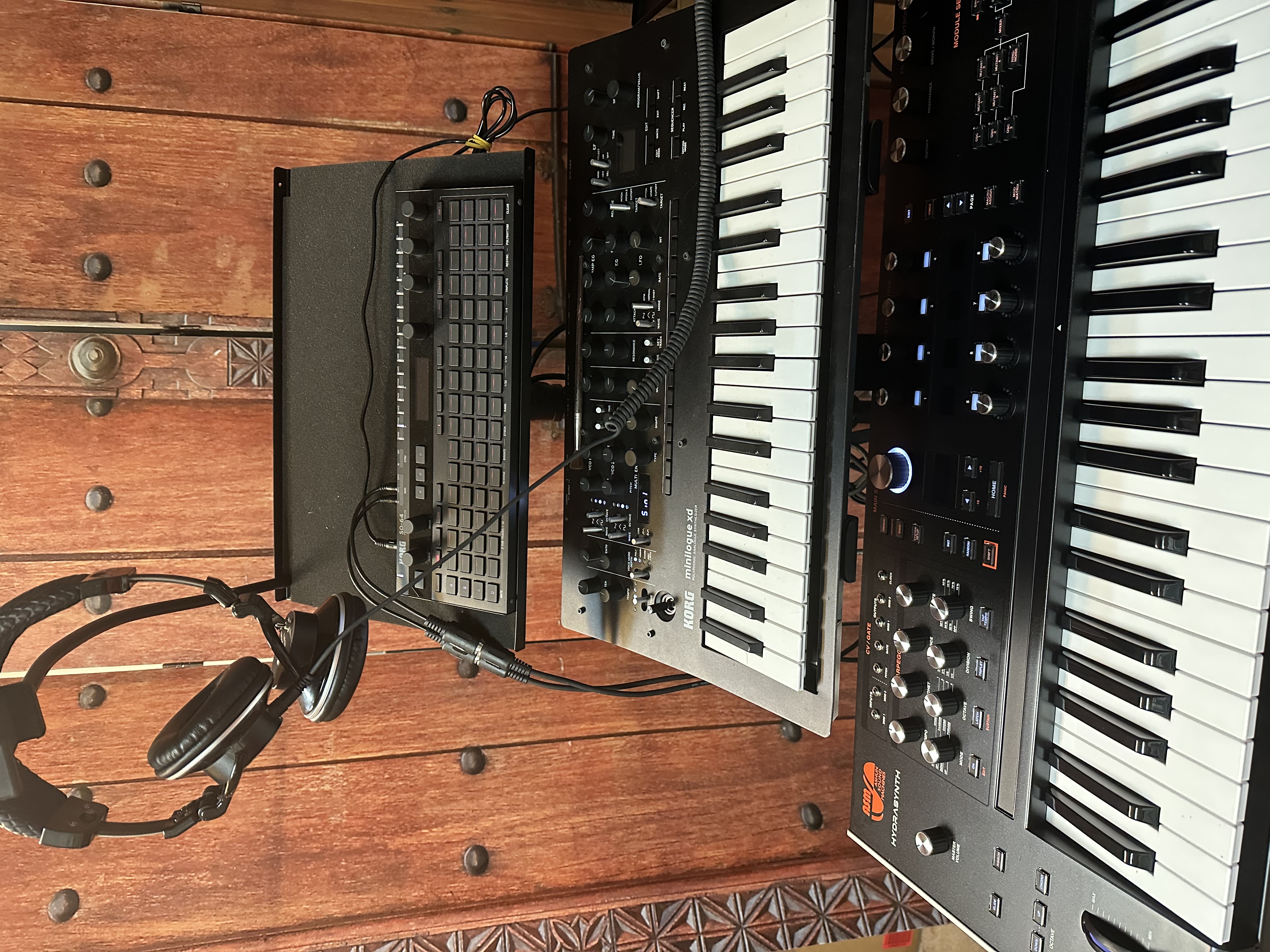 |
Hydrasynth at bottom, Minilogue above it, and the SQ-64 sequencer above that. Out of sight to the right is a Roland E-4 voice tweaker. My 2 Scarlett audio interfaces are hidden behind all of it and transform the sound from the synthesizers into USB signals sent to the Mac running GarageBand audio editor. |
April 30, 2024
Realizing that I am not all that interested in becoming a piano virtuoso, but really more interested in creating "ambient" soundscapes,
I've asked my piano teacher to impart more music theory to me in our lessons, which he is quite good at doing!
So, today we studied the "Phrygian Mode", which sounds exotic and can be made quite spooky. The E Phrygian scale uses only white keys, so it's easy to play.
I promised him by next week I would compose something in E Phrygian, and before midnight, I had actually created something that sounds rich and awesome (to me anyway!)
This is a short 2-1/2 minute excerpt from an hour long composition representing my first attempt at Phrygian:
Spooky Phrygian excerpt
The Hydrasynth keyboard has "aftertouch", meaning I can vary the volume of any note by simply pressing harder without having to take my eyes or hands off the keyboard. You'll hear some of that here.
May 14, 2024
I asked my music theory teacher (notice how I've changed his title to his more correct role) to teach me some ways to create a somber sound that resolves into a more happy mood.
After class, I started experimenting with chords and voicing, such that I could be playing a 3-note chord, move one finger into a new chord, move another finger into yet a different chord, and so on.
I made a table of all the chords from A to G and the notes involved, including all the minor chords.
Then I put it all together into a new composition using both of my synthesizers.
Frisson: goosebumps. Scholars tell us certain people get frisson from hearing a piece that moves them.
I can say that the Tannhaueser overture by Wagner, Finlandia by Sibelius, and certain other works give me not only goosebumps, but might even move me to tears.
Frisson is the way I gauge a really great piece of music.
So imagine my surprise when I started playing the piece I had composed, and got goosebumps.
Imagine my further surprise when I found tears running down my face at certain points in the composition.
I don't know if this piece will do that for you, but I think I have just composed the most beautiful piece of my life.
What do you think of "Frisson"?
This is only the first few minutes of a longer work I've composed. Use good headphones or stereo speakers for the full effect.
Cello, violin, pipe organ, angel choir, flute, bass cello, and an as-yet unnamed synthesizer sound I created.
Next time someone tells you synthesizers produce an awful racket, send them the link.
P.S. I had never seen a synthesizer until 6 months ago.
October 1, 2024
Well, a lot has happened in the last few months. I packed up the Minilogue XD and put it to the side, bought a Strymon Night Sky after-effects box, and I've been composing.
Rather than trying to describe everything I've done, I'll just leave you to these links to some beautiful music I have made with just my Hydrasynth and Night Sky.
(The only purpose for Logic Pro on the Mac was for mixing. I do not ever use VSTs.)
I have created (often from scratch) sound design patches for Oboe, Bassoon, Trumpet, French Horn, Timpani, Violins, Viola, Cello, and the hardest one to synthesize has been a harpsichord. (Did you know it uses plucked strings?)
I have simulated Soprano, Alto, Tenor, and Bass choir voices including the ability to have them sing any vowel fairly realistically.
March 7, 2025
Here are some of my compositions. I have been working on a number of albums full of ambient music on BandCamp.
Check out PalaceOfMind.BandCamp.com for some of the albums you might like.
Worthy Is The Lamb from Haendel's Messiah
Belly Dancing Music (w/Video!)
Midnight in the Wizard's Forest (long-play ambient)
April 4, 2025
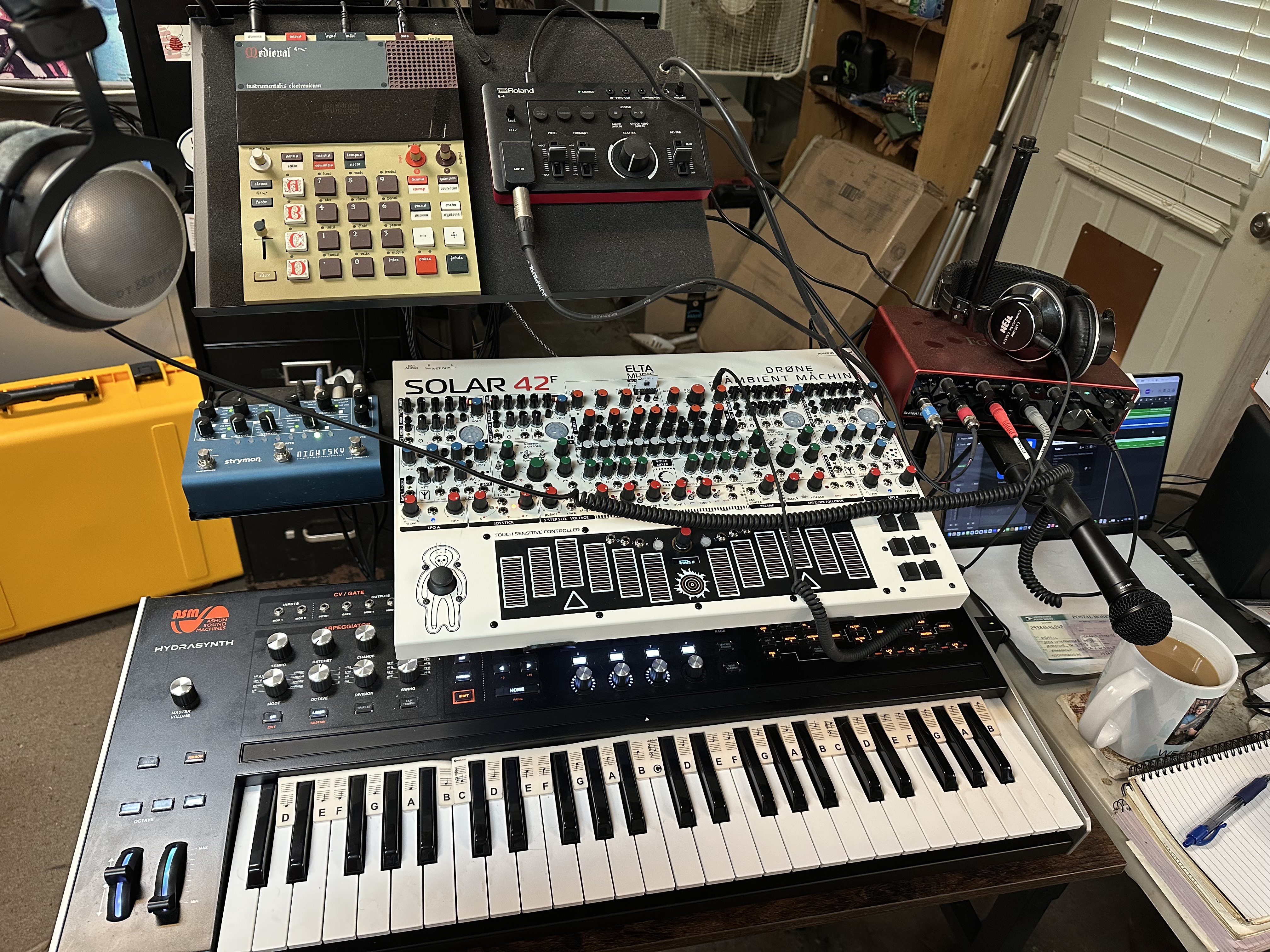
Well my GAS (Gear Acquisition Syndrome) has struck again, and I am the proud owner of a new ELTA Solar 42F,
which is billed as a "Drone Ambient Machine". It's complicated as hell, and you can fire up 24 oscillators at once if it makes sense.
A 12-key keypad with arpeggiator, sequencer, vibrato, and quantizer for many different styles (such as Algerian, Locrian, Gypsy, etc.).
It is supposed to be capable of "cinematic" soundscapes, although it is somewhat limited by the sawtooth waveform on 20 of the osillators.
Here's the first little 5 minutes of playing around with settings on the second day after receiving the shipment.
Occasionally you will hear the extraordinary after-effects of my Strymon NightSky effects box, billed as a "Time-warped Reverberator", which is a total understatement.
The two of them together will produce an unbelievable sound.
Solar 42F Experiments ##1
|
